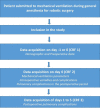International multicenter observational study on assessment of ventilatory management during general anaesthesia for robotic surgery and its effects on postoperative pulmonary complication (AVATaR): study protocol and statistical analysis plan
- PMID: 30139899
- PMCID: PMC6112402
- DOI: 10.1136/bmjopen-2018-021643
International multicenter observational study on assessment of ventilatory management during general anaesthesia for robotic surgery and its effects on postoperative pulmonary complication (AVATaR): study protocol and statistical analysis plan
Abstract
Introduction: Robotic-assisted surgery (RAS) has emerged as an alternative minimally invasive surgical option. Despite its growing applicability, the frequent need for pneumoperitoneum and Trendelenburg position could significantly affect respiratory mechanics during RAS. AVATaR is an international multicenter observational study aiming to assess the incidence of postoperative pulmonary complications (PPC), to characterise current practices of mechanical ventilation (MV) and to evaluate a possible association between ventilatory parameters and PPC in patients undergoing RAS.
Methods and analysis: AVATaR is an observational study of surgical patients undergoing MV for general anaesthesia for RAS. The primary outcome is the incidence of PPC during the first five postoperative days. Secondary outcomes include practice of MV, effect of surgical positioning on MV, effect of MV on clinical outcome and intraoperative complications.
Ethics and dissemination: This study was approved by the Institutional Review Board of the Hospital Israelita Albert Einstein. The study results will be published in peer-reviewed journals and disseminated at international conferences.
Trial registration number: NCT02989415; Pre-results.
Keywords: general anesthesia; mechanical ventilation; postoperative pulmonary complications; robotic surgery.
© Author(s) (or their employer(s)) 2018. Re-use permitted under CC BY-NC. No commercial re-use. See rights and permissions. Published by BMJ.
Conflict of interest statement
Competing interests: None declared.
References
-
- Sullivan MJ, Frost EA, Lew MW. Anesthetic care of the patient for robotic surgery. Middle East J Anaesthesiol 2008;19:967–82. - PubMed
Publication types
MeSH terms
Associated data
LinkOut - more resources
Full Text Sources
Other Literature Sources
Medical

